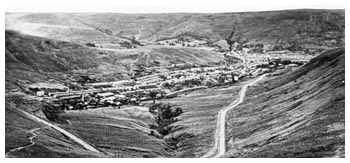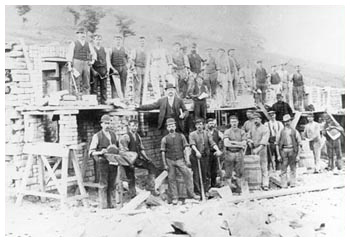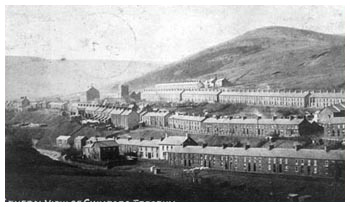
| Cwmparc | |
Early legends tell of a medieval park, or hunting preserve in the area called Parc Cwm Brychiniog, which was subsequently made into four farms in Tudor times, one of which was called Parc Uchaf and another Parc Isaf. Thus the area became known as Cwmparc and its stream Nant Cwmparc ( Cwm being the Welsh for valley), with the development of the mining village in the valley in the 19th Century the village also became known as Cwmparc. |
|
Details of the early history and development of Cwmparc are contained within the booklet, ‘History of Cwmparc. King Coal Invades a Sylvan Valley' which was awarded the prize at Treorchy Semi-National Eisteddfod in 1923. The author describes Cwmparc in 1923 as ‘ a mining village of considerable pretensions, aspiring almost to the more dignified name of township' with a population of about five thousand. He describes the Parc Colliery and further down the valley The Dare, and the constant processions of coal-laden trucks running down the railway that flanked the Parc River. |
A general view of Cwmparc - Circa 1890 |
The building of Tallis Street around 1890 |
The pioneer of Cwmparc's development was David Davies, Llandinam described as, ‘foremost of Welsh industrial kings and founder of the renowned Ocean Coal Company', who had in 1862 negotiated with Crawshay Bailey to commence coal mining on the Tremains Estate. Sinking operations were begun in August 1866 and by the end of that year Parc Pit had produced its first output of coal. He describes how Railway Terrace was the first of the new streets in Cwmparc to be built near to the railway leading from the pithead. The street was known euphemistically as ‘Tub Row' because of the habit of the occupants for leaving their tin bath tubs out on the pavements in the evening, ‘thus setting a trap for, and imperilling the life and limbs of unwary strangers on a dark night'. As for the rest of the village he describes how Parc Road, the main street, ‘ now more than half a mile long', contained the more ‘reputable' buildings, such as the Miners Institute, two hotels and three chapels. He details how, with the influx of population, housing in the early days of Cwmparc was a major problem. |
| In particular he recalls one elderly resident's recollection of how when she came to Cwmparc her family consisting of a mother, father and four children managed to secure accommodation in a shepherd's cottage, Parc Bach. The extent of the overcrowding can be seen when you realise that the cottage already accommodated the shepherd, his family and three other lodgers! With such a demand it was not long before builders and property speculators moved into the area, thus in 1867 Cwmdare Street was completed and most of Parc Street the following year. Tallis Street, Barrett Street and Vicarage Row were soon to follow erected by a local building club enterprise. Tallis Street was named in honour of Mr A.S. Tallis, manager of Dare Colliery and Barrett Street in honour of a well-respected Scottish doctor in the neighbourhood. | |
Thirteen years later in 1936 the author provided an additional chapter to update his work. When looking at the then current state of the village there is quite a different tone from that taken thirteen years previously. He describes the industrial history of the village as being ‘overhung with gloom' and the district as being ‘haunted by the spectre of unemployment'. The village's main employer, and indeed reason for being, The Parc and The Dare pits had always worked intermittently and had been ‘unable to absorb all the eager claimants for work'. There had been moments of industrial strife, notably the 1926 general strike and the ‘stay in' strikes of 1935. In 1954 the National Coal Board merged the two pits, and finally in 1966 after a hundred years of production the Parc and Dare pit closed for the last time, leaving Cwmparc's ‘sylvan' valley to revert in some measure back to its original beauty. |
General view of Cwmparc |
The day war came to Cwmparc |
|
On the night of April 29th/30th 1941 the small mining village of Cwmparc was devastated by the bombs of Hitler's Luftwaffe, an event that survivors of that night of terror will never forget. The reason why this small Rhondda settlement was targeted will never be known, but some theories suggest that possibly a bombing mission planned for Swansea or Port Talbot had failed, causing the German bombers to offload their bombs on their way home. Whatever the reason for the raid the result brought devastation and death to this small close-knit mining community. Most of the bombs fell on houses in Treharne Street and Parc Road, and the resultant death toll was twenty-seven men, women and children. One of the most poignant aspects of the raid was the death of three young evacuees from London. The three, 13-year-old George Jameson, his 11-year-old brother Ernest, and his sister Edith lived at 14 Treharne Street, had been sent to Cwmparc as a place of safety in order to avoid the dangers of the London Blitz. Another victim was Ivor Wright, a member of the local Home Guard. Ivor had seen a parachute floating to the ground, and believing it to be a German parachutist ran to confront the ‘invader', it was however a German incendiary bomb dropped attached to a parachute, which killed him instantly. |
|


